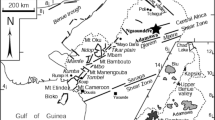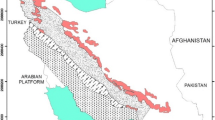Abstract
In Great Nicobar island ophiolite is restricted to the eastern coast of the island and occur as small isolated out crops in the terrain of Oligocene sediments. The ophiolitic rocks are represented by pillowed basalt, massive andesite and pyroclastic andesite. These volcanics represent dismembered members of the upper part of the ophiolite. Basalt is porphyritic in nature where phenocrysts of augite and plagioclase laths are set in a fine grained glassy to chloritic matrix. Andesites consists of phenocrysts of augite, altered feldspar and minor quartz which are set in ground mass of epidote-chlorite glass. Trace element and REE pattern suggests more fertile mantle source for andesite than that of basalt. Trace element characteristics indicate that the andesites and basalts were possibly derived from the same melt where andesite represents the more fractionated product.
In Andaman Islands dismembered ophiolite with complete ophiolite stratigraphy are found only within the Eocene sediments. But the field disposition suggests that in Great Nicobar emplacement of the ophiolite continued even after the Oligocene sedimentation. The characters of the ophiolitic rocks in Great Nicobar island are similar to that of the Sunda outer arc ridge.
Similar content being viewed by others
References
Acharyya, S.K., Ray, K.K. and Roy, D.K. (1989) Tectonostratigraphy and emplacement history of the ophiolite assemblage from Naga Hills and Andaman Island arc, India. Jour. Geol. Soc. India, v.33, pp.4–18.
Acharyya, S.K. (2007) Collisional emplacement history of the Naga-Andaman ophiolites and the position of the eastern Indian suture, Jour. Asian Earth Sci., v.29(2–3), pp. 229–242.
Boynton, W.V. (1984) Geochemistry of the rare-earth elements: meteorite studies. In: Henderson, P. (Ed.), Rare Earth Element Geochemistry, Elsevier, Amsterdam, pp. 63–114.
Cox, K.G., Bell, J.D. and Pankhurst, R.J. (1979) The Interpretation of Igneous Rocks: London, England, George Allen & Unwin, Ltd., 450p.
Curray, J.R. and Moore, D.G. (1974) Sedimentary and tectonic processes in the Bengal deep sea fan and geosyncline. In: Burke, C.A. and Drake, C.L. (Eds). The geology of continental margins, Springer Verlag. New York, pp.617–27.
Haldar, D. (1985) Some aspects of Andaman ophiolite complex. Rec. Geol. Surv. India, v.115, pp.1–11.
Irvine, T.N. and Baragar, W.R.A. (1971) A guide to the chemical classification of the common volcanic rocks: Canadian Jour. Earth Sci., v.8, pp.523–548.
Karig, D.E., Suparka, S., Moore, G. F. and Hehanussa, P.E. (1979) Structure and Cenozoic evolution of the Sunda arc in the Central Sumatra Region. In: Watkins. J.S., Montadert, L. and Dickinson, P.W. (Eds.) Geological and Geophysical investigations of Continental Margins. AAPG Mem., =no.29, pp.223–237.
Mitchell, A.G.H. (1985) Collision related fore-arc and back-arc evolution of the Northern Sunda arc. Tectonophysics, v.116, pp.323–334.
Moore, G.F., Bullman, H.G., Hehanussa, P.E. and Karig, D.E., (1980) Sedimentology and paleobathymetry of Neogene trench-slope deposits, Nias Island, Indonesia. Jour. Geol., v.88, pp.161–180.
Mukhopadhyay, M. (1988) Gravity anomalies and deep structure of the Andaman Arc. Marine Geophys. Res., v.9, pp.197–211.
Mullen, E.D. (1983) MnO/TiO2/P2O5: a minor element discriminant for basaltic rocks of oceanic environments and its implications for petrogenesis. Earth Planet. Sci. Lett., v.62, pp.53–62.
Pal, T., Chakraborty, P. P., Duttagupta, T. and Singh, C.D. (2003) Geodynamic evolution of an outer arc in convergent margin of active Burma-Java subduction complex, a document from Andaman islands, Bay of Bengal. Geol. Mag., v.140, pp.289–307.
Pal, T. (2011) Petrology and geochemistry of the Andaman ophiolite: meltrock interaction in a suprasubduction-zone setting. Petrology and geochemistry of the Andaman ophiolite: melt-rock interaction Jour. Geol. Soc., v.168, pp.1031–1045.
Pearce, J.A. (1996) A User’s Guide to Basalt Discrimination Diagrams. In: Wyman, D.A. (Ed.), Trace Element Geochemistry of Volcanic Rocks: Applications for Massive Sulphide Exploration. Geological Association of Canada, Short Course Notes 12, pp.79–113.
Pearce, J.A. and Cann, J.R. (1973) Tectonic setting of basic volcanic rocks determined using trace element analyses. Earth Planet. Sci. Lett., v.19, pp.290–300.
Pearce, T.H., Gorman, B.E. and Birkett, T.C. (1977) The relationship between major element geochemistry and tectonic environment of basic and intermediate volcanic rocks. Earth Planet. Sci. Lett., v.36, pp.121–132.
Pedersen, R. B., Searle, M. P., Carter, A. and Bandopadhyay, P. C, (2010) U–Pb zircon age of the Andaman ophiolite: implications for the beginning of subduction beneath the Andaman–Sumatra arc, Jour. Geol. Soc., v.167, pp.1105–1112.
Ray, K.K. (1982) A review of the geology of Andaman and Nicobar islands. Geol. Surv. India Misc. Publ., v.42(2), pp.110–125.
Roy, D.K., Acharyya, S.K., Ray, K.K., Lahiri, T.C. and Sen, M.K. (1988) Nature of occurrence and depositional environment of the oceanic pelagic sediments associated with the ophiolite assemblage, South Andaman Island. Indian Minerals, v.42, pp.1–56.
Sun, S.S. and McDonough, W.F. (1989) Chemical and isotopic systematics of oceanic basalts: implications for mantle composition and processes. In: A.D. Saunders and M.J. Norry (Eds.), Magmatism in Ocean Basins. Geol. Soc. London, Spec. Publ., pp.313–345.
Vohra, C.P., Haldar, D. and Ghosh, Roy, A.K. (1989) The Andaman Nicobar Ophiolites Complex and associated mineral resources current appraisal. Phanerozoic Ophiolites of India. In: N.C. Ghose (Ed.), Sumna Publi., Patna, pp.281–315.
Winchester, J.A. and Floyd, P.A. (1977) Geochemical discrimination of different magma series and their differentiation products using immobile elements. Chem. Geol., v.20, pp.325–343.
Author information
Authors and Affiliations
Corresponding author
Rights and permissions
About this article
Cite this article
Sachin, R., Verma, S. & Pal, T. Petrochemical and petrotectonic characterisation of ophiolitic volcanics from Great Nicobar island Andaman-Sumatra belt. J Geol Soc India 90, 85–92 (2017). https://doi.org/10.1007/s12594-017-0667-y
Received:
Revised:
Published:
Issue Date:
DOI: https://doi.org/10.1007/s12594-017-0667-y




